Interview With Mae Jemison
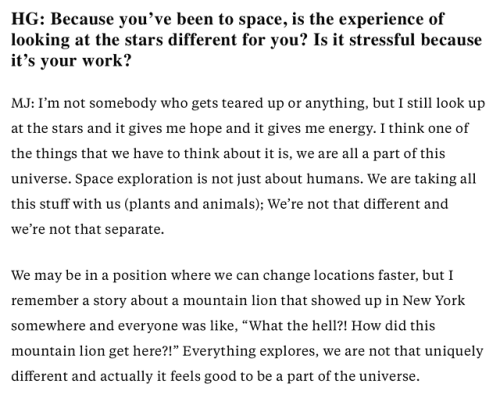
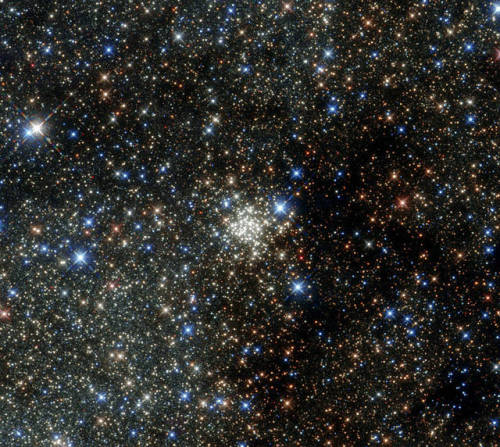
Interview with Mae Jemison
https://hellogiggles.com/news/first-african-american-woman-astronaut-mae-jemison-talks-to-us-about-going-to-mars/
Arches Cluster
This NASA/ESA Hubble Space Telescope image presents the Arches Cluster, the densest known star cluster in the Milky Way. It is located about 25,000 light-years from Earth in the constellation of Sagittarius (The Archer), close to the heart of our galaxy, the Milky Way. It is, like its neighbor the Quintuplet Cluster, a fairly young astronomical object at between two and four million years old.
The Arches cluster is so dense that in a region with a radius equal to the distance between the sun and its nearest star there would be over 100,000 stars! At least 150 stars within the cluster are among the brightest ever discovered in the Milky Way. These stars are so bright and massive that they will burn their fuel within a short time (on a cosmological scale that means just a few million years). Then they will die in spectacular supernova explosions. Due to the short lifetime of the stars in the cluster the gas between the stars contains an unusually high amount of heavier elements, which were produced by earlier generations of stars.
Despite its brightness the Arches Cluster cannot be seen with the naked eye. The visible light from the cluster is completely obscured by gigantic clouds of dust in this region. To make the cluster visible astronomers have to use detectors which can collect light from the X-ray, infrared, and radio bands, as these wavelengths can pass through the dust clouds. This observation shows the Arches Cluster in the infrared and demonstrates the leap in Hubble’s performance since its 1999 image of same object.
Image credit: NASA/ESA Text credit: European Space Agency
More Posts from Womeninspaceexploration and Others
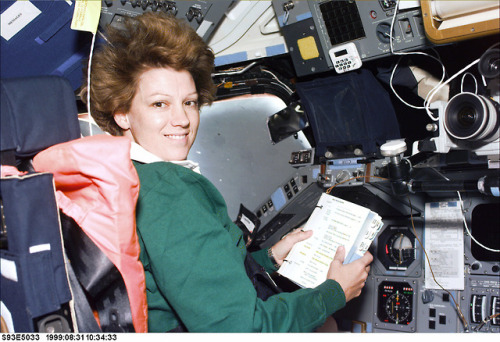
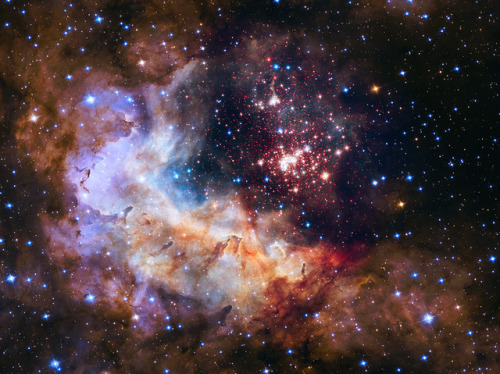
Columbia Commander Eileen Collins
(July 24, 1999) Commander Eileen Collins consults a checklist while seated at the flight deck Commander's station in the Shuttle Columbia during STS-93.
Image # : S93E5033
Hubble Space Telescope Celebrates 25 Years of Unveiling the Universe
The brilliant tapestry of young stars flaring to life resemble a glittering fireworks display in the 25th anniversary NASA Hubble Space Telescope image to commemorate a quarter century of exploring the solar system and beyond since its launch on April 24, 1990.
The sparkling centerpiece of Hubble's silver anniversary fireworks is a giant cluster of about 3,000 stars called Westerlund 2, named for Swedish astronomer Bengt Westerlund, who discovered the grouping in the 1960s. The cluster resides in a raucous stellar breeding ground known as Gum 29, located 20,000 light-years away from Earth in the constellation Carina.
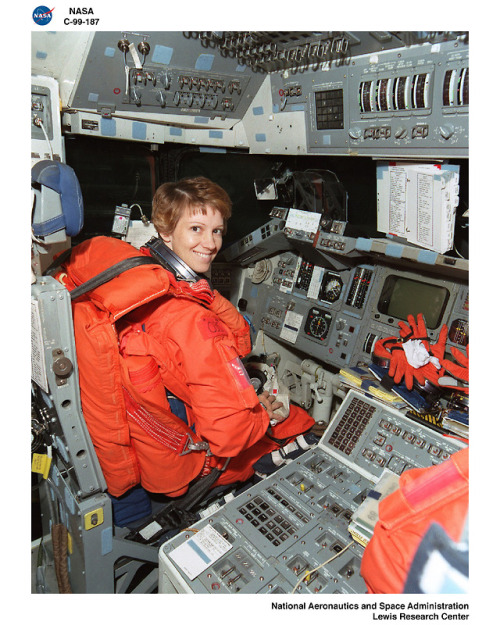
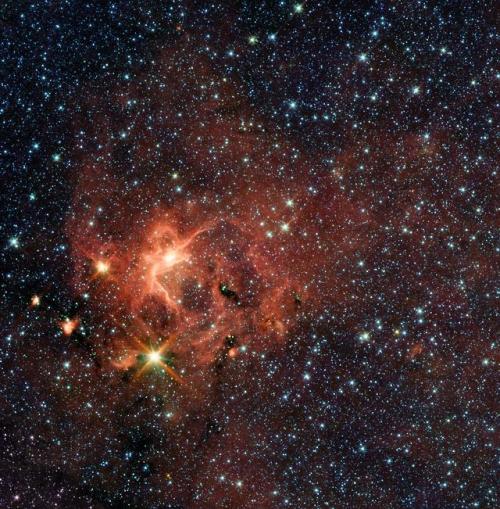
Massive Young Star and its Cradle
NASA ID: PIA13276
Date Created: 2010-07-14
This star-forming region, captured by NASA Spitzer Space Telescope, is dominated by the bright, young star IRAS 13481-6124; it is the first massive baby star for which astronomers could obtain a detailed look at the dusty disk closely encircling it.


Chawla prepares the CM for installation of MIST in the SH during STS-107
STS-107 Mission Specialist 2 MS Kalpana 'KC' Chawla reads a checklist in the Spacehab SH Research Double Module RDM as she prepares the Combustion Module CM-2 for installation of the Water Mist Fire Suppression Experiment MIST.
Kalpana Chawla
(March 17, 1962 – February 1, 2003) was an American astronaut, engineer, and the first female of Indian origin to go to space. She first flew on Space Shuttle Columbia in 1997 as a mission specialist and primary robotic arm operator. In 2003, Chawla was one of the seven crew members who died in the Space Shuttle Columbia disaster when the spacecraft disintegrated during its re-entry into the Earth's atmosphere. Chawla was posthumously awarded the Congressional Space Medal of Honor, and several streets, universities and institutions have been named in her honor.
Hubble Looks Into a Cosmic Kaleidoscope
At first glance, this cosmic kaleidoscope of purple, blue and pink offers a strikingly beautiful — and serene — snapshot of the cosmos. However, this multi-colored haze actually marks the site of two colliding galaxy clusters, forming a single object known as MACS J0416.1-2403 (or MACS J0416 for short).
MACS J0416 is located about 4.3 billion light-years from Earth, in the constellation of Eridanus. This image of the cluster combines data from three different telescopes: the NASA/ESA Hubble Space Telescope (showing the galaxies and stars), the NASA Chandra X-ray Observatory (diffuse emission in blue), and the NRAO Jansky Very Large Array (diffuse emission in pink). Each telescope shows a different element of the cluster, allowing astronomers to study MACS J0416 in detail.
As with all galaxy clusters, MACS J0416 contains a significant amount of dark matter, which leaves a detectable imprint in visible light by distorting the images of background galaxies. In this image, this dark matter appears to align well with the blue-hued hot gas, suggesting that the two clusters have not yet collided; if the clusters had already smashed into one another, the dark matter and gas would have separated. MACS J0416 also contains other features — such as a compact core of hot gas — that would likely have been disrupted had a collision already occurred.
Together with five other galaxy clusters, MACS J0416 is playing a leading role in the Hubble Frontier Fields program, for which this data was obtained. Owing to its huge mass, the cluster is in fact bending the light of background objects, acting as a magnifying lens. Astronomers can use this phenomenon to find galaxies that existed only hundreds of million years after the big bang.
For more information on both Frontier Fields and the phenomenon of gravitational lensing, see Hubblecast 90: The final frontier.
Text credit: European Space Agency Image credit: NASA, ESA, CXC, NRAO/AUI/NSF, STScI, and G. Ogrean (Stanford University), Acknowledgment: NASA, ESA, and J. Lotz (STScI), and the HFF team


Microgravity
NASA ID: 9515855
Date Created: 1995-10-20
Onboard STS-73, USML-2: Mission Specialist, Payload Commander, Kathryn Thorton with (CGF) Crystal Growth Furnace
Witch Head Nebula
Image Credit: NASA/STScI Digitized Sky Survey/Noel Carboni
As the name implies, this reflection nebula associated with the star Rigel looks suspiciously like a fairytale crone. Formally known as IC 2118 in the constellation Orion, the Witch Head Nebula glows primarily by light reflected from the star. The color of this very blue nebula is caused not only by blue color of its star, but also because the dust grains reflect blue light more efficiently than red. A similar physical process causes Earth's daytime sky to appear blue.


Materials Science Experiments Conducted at MSFC
In another first for NASA, an all-female crew of scientific experimenters began a five-day exercise on December 16, 1974, to test the feasibility of experiments that were later tested on the Space Shuttle/Spacelab missions. The experimenters, Dr. Mary H. Johnston (seated, left), Ann F. Whitaker and Carolyn S. Griner (standing, left to right), and the crew chief, Doris Chandler, spent spend eight hours each day of the mission in the Marshall Space Flight Centers General Purpose Laboratory (GPL). They conducted 11 selected experiments in materials science to determine their practical application for Spacelab missions and to identify integration and operational problems that might occur on actual missions.
Image # :565782
Date: November 13, 1974
N81 in the Small Magellanic Cloud
A NASA Hubble Space Telescope "family portrait" of young, ultra-bright stars nested in their embryonic cloud of glowing gases. The celestial maternity ward, called N81, is located 200,000 light-years away in the Small Magellanic Cloud (SMC), a small irregular satellite galaxy of our Milky Way. Hubble's exquisite resolution allows astronomers to pinpoint 50 separate stars tightly packed in the nebula's core within a 10 light- year diameter - slightly more than twice the distance between earth and the nearest star to our sun. The closest pair of stars is only 1/3 of a light-year apart (0.3 arcseconds in the sky). This furious rate of mass loss from these super-hot stars is evident in the Hubble picture that reveals dramatic shapes sculpted in the nebula's wall of glowing gases by violent stellar winds and shock waves. A pair of bright stars in the center of the nebula is pouring out most of the ultraviolet radiation to make the nebula glow. Just above them, a small dark knot is all that is left of the cold cloud of molecular hydrogen and dust the stars were born from. Dark absorption lanes of residual dust trisect the nebula. The nebula offers a unique opportunity for a close-up glimpse at the firestorm' accompanying the birth of extremely massive stars, each blazing with the brilliance of 300,000 of our suns. Such galactic fireworks were much more common billions of years ago in the early universe, when most star formation took place. The "natural- color" view was assembled from separate images taken with the Wide Field and Planetary Camera 2, in ultraviolet light and two narrow emission lines of ionized Hydrogen (H-alpha, H-beta).
Image # : PR98-25
Date: September 24, 1997
Facts About Women in Space Exploration
1. In 1963 Valentina Tereshkova became the first woman sent to space, just two years after her male counterpart Yuri Gagarin. (only 12 other men had been to space at the time) article
2. Women make up less than 11 percent of history’s space explorers.
3. 538 total space travelers, 62 have been women.
4. A span of 19 years separated the first and second women in space.

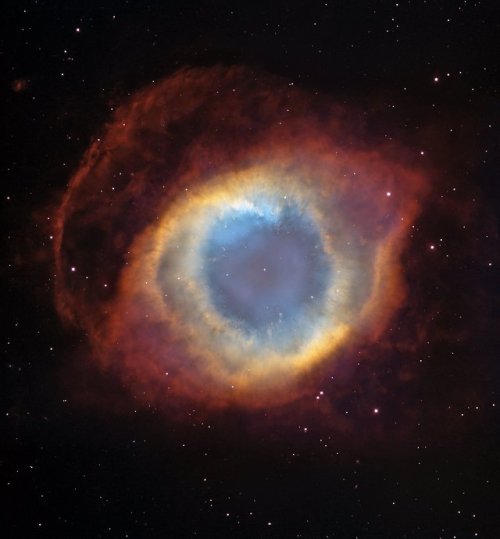
SALLY RIDE, FIRST AMERICAN WOMAN IN SPACE, DISCUSSES BEING AN ASTRONAUT WITH GLORIA STEINEM
https://rocket-women.com/2016/02/sally-ride-first-american-woman-in-space-discusses-being-an-astronaut-with-gloria-steinem/
“Eye of God”
About this image
This composite image is a view of the colorful Helix Nebula taken with the Advanced Camera for Surveys aboard NASA's Hubble Space Telescope and the Mosaic II Camera on the 4-meter telescope at Cerro Tololo Inter-American Observatory in Chile. The object is so large that both telescopes were needed to capture a complete view. The Helix is a planetary nebula, the glowing gaseous envelope expelled by a dying, sun-like star. The Helix resembles a simple doughnut as seen from Earth. But looks can be deceiving. New evidence suggests that the Helix consists of two gaseous disks nearly perpendicular to each other.
One possible scenario for the Helix's complex structure is that the dying star has a companion star. One disk may be perpendicular to the dying star's spin axis, while the other may lie in the orbital plane of the two stars. The Helix, located 690 light-years away, is one of the closest planetary nebulas to Earth.
The Hubble images were taken on November 19, 2002; the Cerro Tololo images on Sept. 17-18, 2003.

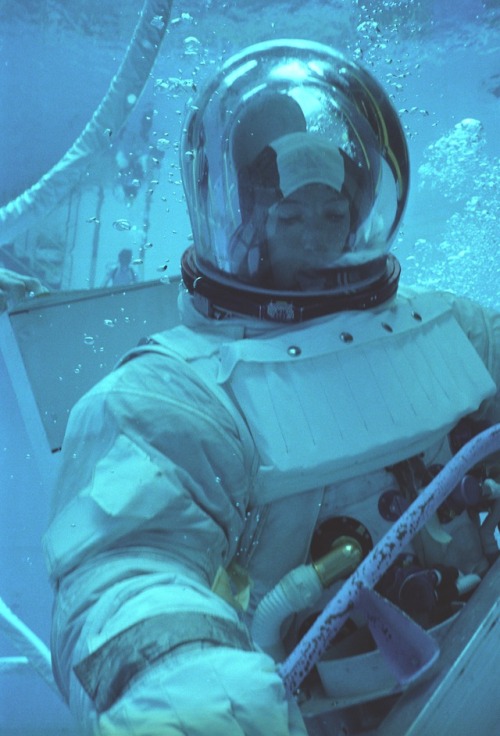
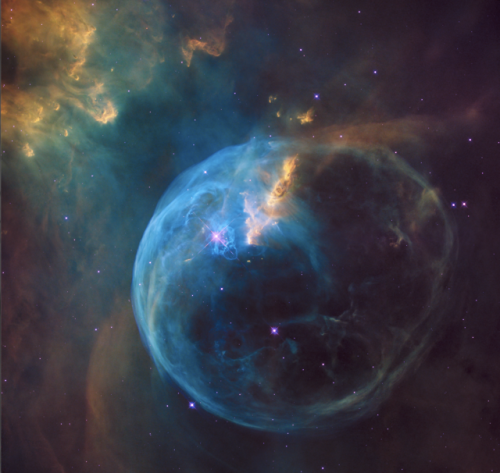
History of Hubble Space Telescope (HST)
NASA ID: 8004550
Date Created: 1980-05-08
The Hubble Space Telescope (HST) is a cooperative program of the European Space Agency (ESA) and the National Aeronautical and Space Administration (NASA) to operate a long-lived space-based observatory. It was the flagship mission of NASA's Great Observatories program. The HST program began as an astronomical dream in the 1940s. During the 1970s and 1980s, the HST was finally designed and built becoming operational in the 1990s. The HST was deployed into a low-Earth orbit on April 25, 1990 from the cargo bay of the Space Shuttle Discovery (STS-31). The design of the HST took into consideration its length of service and the necessity of repairs and equipment replacement by making the body modular. In doing so, subsequent shuttle missions could recover the HST, replace faulty or obsolete parts and be re-released. Marshall Space Flight Center’s (MSFC's) Neutral Buoyancy Simulator (NBS) served as the test center for shuttle astronauts training for Hubble related missions. Shown is astronaut Anna Fisher training on a mock-up of a modular section of the HST for an axial scientific instrument change out.
Hubble Sees a Star ‘Inflating’ a Giant Bubble
NASA ID: GSFC_20171208_Archive_e000383
Date Created: 12/8/2017
For the 26th birthday of NASA’s Hubble Space Telescope, astronomers are highlighting a Hubble image of an enormous bubble being blown into space by a super-hot, massive star. The Hubble image of the Bubble Nebula, or NGC 7635, was chosen to mark the 26th anniversary of the launch of Hubble into Earth orbit by the STS-31 space shuttle crew on April 24, 1990 “As Hubble makes its 26th revolution around our home star, the sun, we celebrate the event with a spectacular image of a dynamic and exciting interaction of a young star with its environment. The view of the Bubble Nebula, crafted from WFC-3 images, reminds us that Hubble gives us a front row seat to the awe inspiring universe we live in,” said John Grunsfeld, Hubble astronaut and associate administrator of NASA’s Science Mission Directorate at NASA Headquarters, in Washington, D.C. The Bubble Nebula is seven light-years across—about one-and-a-half times the distance from our sun to its nearest stellar neighbor, Alpha Centauri, and resides 7,100 light-years from Earth in the constellation Cassiopeia. The seething star forming this nebula is 45 times more massive than our sun. Gas on the star gets so hot that it escapes away into space as a “stellar wind” moving at over four million miles per hour. This outflow sweeps up the cold, interstellar gas in front of it, forming the outer edge of the bubble much like a snowplow piles up snow in front of it as it moves forward. As the surface of the bubble's shell expands outward, it slams into dense regions of cold gas on one side of the bubble. This asymmetry makes the star appear dramatically off-center from the bubble, with its location in the 10 o’clock position in the Hubble view. Dense pillars of cool hydrogen gas laced with dust appear at the upper left of the picture, and more “fingers” can be seen nearly face-on, behind the translucent bubble. The gases heated to varying temperatures emit different colors: oxygen is hot enough to emit blue light in the bubble near the star, while the cooler pillars are yellow from the combined light of hydrogen and nitrogen. The pillars are similar to the iconic columns in the “Pillars of Creation” Eagle Nebula. As seen with the structures in the Eagle Nebula, the Bubble Nebula pillars are being illuminated by the strong ultraviolet radiation from the brilliant star inside the bubble. The Bubble Nebula was discovered in 1787 by William Herschel, a prominent British astronomer. It is being formed by a proto-typical Wolf-Rayet star, BD +60º2522, an extremely bright, massive, and short-lived star that has lost most of its outer hydrogen and is now fusing helium into heavier elements. The star is about four million years old, and in 10 million to 20 million years, it will likely detonate as a supernova. Hubble’s Wide Field Camera-3 imaged the nebula in visible light with unprecedented clarity in February 2016. The colors correspond to blue for oxygen, green for hydrogen, and red for nitrogen. This information will help astronomers understand the geometry and dynamics of this complex system. The Bubble Nebula is one of only a handful of astronomical objects that have been observed with several different instruments onboard Hubble. Hubble also imaged it with the Wide Field Planetary Camera (WFPC) in September 1992, and with Wide Field Planetary Camera-2 (WFPC2) in April 1999. The Hubble Space Telescope is a project of international cooperation between NASA and the European Space Agency. NASA's Goddard Space Flight Center in Greenbelt, Maryland, manages the telescope. The Space Telescope Science Institute (STScI) in Baltimore, Maryland, conducts Hubble science operations. STScI is operated for NASA by the Association of Universities for Research in Astronomy in Washington, D.C. Credit: NASA, ESA, and the Hubble Heritage Team (STScI/AURA)

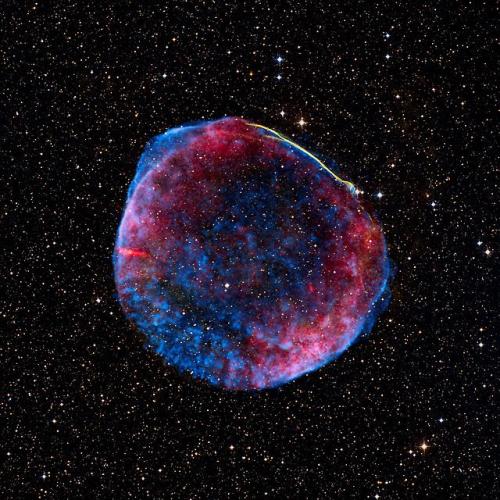
Sally K. Ride
Title: Sally K. Ride
Catalog #: WOF_00203
Additional Information: Astronaut
Item Location: Women of Flight Box 3
Collection: Women of Flight Special Collection
Tags: Women of Flight Photo, Sally K. Ride
Repository: San Diego Air and Space Museum Archive
Hubble Sees Stars and a Stripe in Celestial Fireworks
Creator: NASA Goddard
Date Created: 12/8/2017
NASA ID: GSFC_20171208_Archive_e002166
Release date: July 1, 2008 This image is a composite of visible (or optical), radio, and X-ray data of the full shell of the supernova remnant from SN 1006. The radio data show much of the extent that the X-ray image shows. In contrast, only a small linear filament in the northwest corner of the shell is visible in the optical data. The object has an angular size of roughly 30 arcminutes (0.5 degree, or about the size of the full moon), and a physical size of 60 light-years (18 parsecs) based on its distance of nearly 7,000 light-years. The small green box along the bright filament at the top of the image corresponds to the dimensions of the Hubble release image. The optical data was obtained at the University of Michigan's 0.9-meter Curtis Schmidt telescope at the National Science Foundation's Cerro Tololo Inter-American Observatory (CTIO) near La Serena, Chile. H-alpha, continuum-subtracted data were provided by F. Winkler (Middlebury COllege) et al. The X-ray data were acquired from the Chandra X-ray Observatory's AXAF CCD Imaging Spectrometer (ACIS) at 0.5-3keV, and were provided by J. Hughes (Rutgers University) et al. The radio data, supplied by K. Dyer (NRAO, Socorro) et al., were a composite from the National Radio Astronomy Observatory's Very Large Array (NRAO/VLA) in Socorro, New Mexico, along with the Green Bank Telescope (GBT) in Green Bank, West Virginia. Data of the supernova remnant were blended on a visible-light stellar background created using the Digitized Sky Survey's Anglo-Australian Observatory (AAO2) blue and red plates. Photo Credit: NASA, ESA, and Z. Levay (STScI) Science Credit: Radio: NRAO/AUI/NSF GBT+VLA 1.4 GHz mosaic (Dyer, Maddalena and Cornwell, NRAO); X-ray: NASA/CXC/Rutgers/G. Cassam-Chenai and J. Hughes et al.; Optical: F.Winkler/Middlebury College and NOAO/AURA/NSF; and DSS
